Section 1: Agency overview and resources
1.1 Strategic direction
The Office of the Auditing and Assurance Standards Board (AUASB) is an Australian Government agency under the Australian Securities and Investments Commission Act 2001.
The functions of the AUASB are to:
- make auditing standards under section 336 of the Corporations Act 2001 for the purposes of the corporations legislation;
- formulate auditing and assurance standards for other purposes;
- formulate guidance on auditing and assurance matters;
- participate in and contribute to the development of a single set of auditing standards for world-wide use; and
- advance and promote the main objectives of part 12 of the Australian Securities and Investments Commission Act 2001.
The vision of the AUASB is to be recognised as a leading national auditing and assurance standards setting body that develops high quality auditing and assurance standards and guidance in the public interest.
The mission of the AUASB is to develop, in the public interest, high quality auditing and assurance standards and related guidance as a means to enhance the relevance, reliability and timeliness of information provided to users of audit and assurance services.
Key strategies during 2011-12 include to:
- develop auditing and assurance standards and guidance;
- identify emerging auditing and assurance issues;
- contribute to and influence the development of international auditing standards; and
- promote awareness and understanding of the AUASB role and work program, auditor responsibilities, and the role of auditing and assurance services.
1.2 Agency resource statement
Table 1.1 shows the total resources from all sources. The table summarises how resources will be applied by outcome and departmental classification.
Table 1.1: Office of the Auditing and Assurance Standards Board resource statement — Budget
estimates for 2011-12 as at Budget May 2011
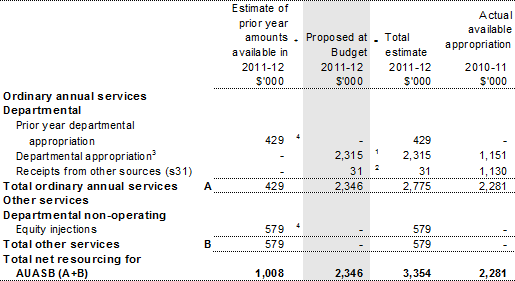
1. Appropriation Bill (No. 1) 2011-12.
2. Receipts received under s31 of the Financial Management and Accountability Act 1997.
3. Includes an amount of $0.05 million in 2011-12 for the departmental capital budget (refer to Table 3.2.5 for further details).
4. Estimated adjusted balance carried from previous year for annual appropriations.
1.3 Budget measures
Budget measures relating to the AUASB are detailed in Budget Paper No. 2, Budget Measures 2011-12 and are summarised below.
Table 1.2: Office of the Auditing and Assurance Standards Board 2011-12 Budget measures
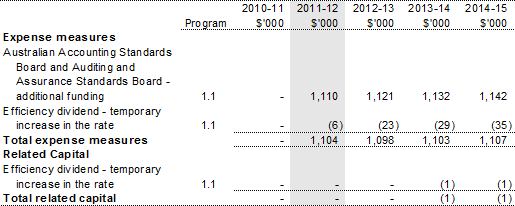
Prepared on a government finance statistics (fiscal) basis.
Section 2: Outcomes and planned performance
2.1 Outcomes and performance information
Government outcomes are the intended results, impacts or consequences of actions by the Government on the Australian community. Commonwealth programs are the primary vehicle by which government agencies achieve the intended results of their outcome statements. Agencies are required to identify the programs which contribute to Government outcomes over the Budget and forward years.
The AUASB's outcome is described below, specifying the strategy, program objective, program deliverables and program key performance indicators used to assess and monitor the performance of the AUASB.
Outcome 1: The formulation and making of auditing and assurance standards that are used by auditors of Australian entity financial reports or for other auditing and assurance engagements
Outcome 1 strategy
The key strategies to achieve Outcome 1 are:
- making auditing standards under section 336 of the Corporations Act 2001 and related guidance for use by Australian auditors who are undertaking audit engagements for the purposes of the Corporations legislation, including facilitating and monitoring the implementation of the revised 'Clarity' Australian Auditing Standards;
- formulating auditing and assurance standards and related guidance for use by Australian auditors who are undertaking auditing or assurance engagements for purposes other than the purposes of the Corporations legislation;
- providing Australian participation in, and contribution to, the development of a single set of auditing standards for world-wide use; and
- the AUASB continuing its role in the development of auditing and assurance standards guidance, identifying emerging auditing and assurance issues and contributing to and influencing the development of international auditing standards.
Outcome expense statement
Table 2.1 provides an overview of the total expenses for Outcome 1.
Table 2.1: Budgeted expenses for Outcome 1
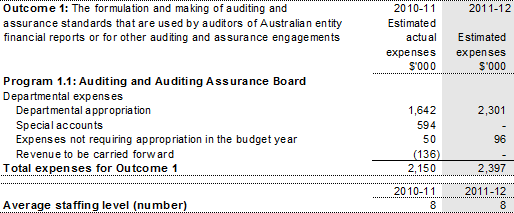
Contributions to Outcome 1
Program 1.1: Auditing and Assurance Standards Board
Program objective
Formulate and maintain Auditing Standards (ASAs) that are legally enforceable under the Corporations Act 2001 and contribute to the development of international auditing standards.
Contribute to the successful implementation of the 'Clarity' Auditing Standards applicable to financial reporting periods that commenced on or after 1 January 2010, including:
- development of articles that will highlight key principles;
- presenting at various public forums, conferences and information sessions; and
- monitoring the implementation of the revised 'Clarity' Australian Auditing Standards and providing periodic and formal feedback to the International Auditing and Assurance Standards Board (IAASB), which has established a project monitoring task force for this purpose.
Formulate and maintain other auditing and assurance standards, ensuring quality and complete coverage of relevant auditing and assurance subjects including:
- assurance framework;
- assurance engagements other than on historical financial statements;
- engagements to perform agreed-upon procedures;
- fundraising engagements including prospective financial information;
- comfort letter engagements;
- assurance on greenhouse gas emissions reports;
- assurance on water accounting reports;
- standards on review engagements; and
- assurance on internal control.
Formulate and maintain guidance pronouncements, ensuring that guidance is high quality, timely and provides appropriate coverage through pronouncements that supplement standards and address emerging issues including:
- the Australian Prudential Regulation Authority and the Australian Securities and Investments Commission regulated areas;
- application of auditing standards to audits and reviews of smaller entities — for example, small not-for-profit entities;
- auditing complex financial instruments;
- private letter requests; and
- auditing grant acquittals.
Influence the development of international and national standards by liaising with the IAASB and other national standard-setting organisations to contribute to improving the quality of global auditing and assurance standards, including working more closely with the New Zealand Professional Standards Board to maximi
se consistency in auditing standards and undertake joint projects where possible, consistent with the Outcome Proposals agreed in August 2009 by the Australian and New Zealand Prime Ministers.
Through research, communications and consultations to identify and respond to emerging issues on a timely basis, including participating in the early stages of the development of legislation and regulation to better define audit requirements, including:
- development of AUASB Bulletins on various current topics relating to the Board's areas of interest;
- preparation of a discussion paper on internal control;
- promoting thought leadership on the importance of achieving and heightening audit quality; and
- track local and international auditing and assurance research projects and consider implications for the AUASB.
Through a detailed communication and consultation plan, the AUASB strategy is to increase awareness of the AUASB's work among its stakeholders, and to ensure that stakeholders' views are appropriately considered in the AUASB activities and initiatives.
Program expenses
There are no significant changes to estimates across the forward years.
Table 2.2 Program expenses

Program deliverables
The AUASB has the following deliverables:
- prepare and issue auditing standards under section 336 of the Corporations Act 2001;
- prepare and issue new and revised assurance standards, standards on review engagements and related guidance; and
- contribute to the development of international auditing and assurance standards.
Program key performance indicators
The AUASB has the following key performance indicators:
- issued auditing standards are of the highest quality, developed on a timely basis, are consistent with those developed by the IAASB and are based on the 'Clarity' versions of International Standards on Auditing;
- issued assurance standards and standards on review engagements are of the highest quality and are developed on a timely basis;
- relevant guidance is issued to auditors, assurance practitioners and other users, as appropriate, on a timely basis;
- emerging auditing and assurance issues are identified and addressed on a timely basis;
- responses are made to all significant IAASB exposure drafts; and
- appropriate input is provided to the IAASB.
Section 3: Explanatory tables and budgeted financial statements
Section 3 presents explanatory tables and budgeted financial statements which provide a comprehensive snapshot of agency finances for the 2011-12 budget year. It explains how budget plans are incorporated into the financial statements and provides further details of the reconciliation between appropriations and program expenses, movements in administered funds, special accounts and government Indigenous expenditure.
3.1 Explanatory tables
3.1.1 Movement of administered funds between years
The AUASB does not have any administered funds.
3.1.2 Special accounts
Special accounts provide a means to set aside and record amounts used for specified purposes. Special accounts can be created by a Finance Minister's Determination under the Financial Management and Accountability Act 1997 or under separate enabling legislation. Table 3.1.2 shows the expected additions (receipts) and reductions (payments) for each account used by the AUASB.
Table 3.1.2: Estimates of special account cash flows and balances
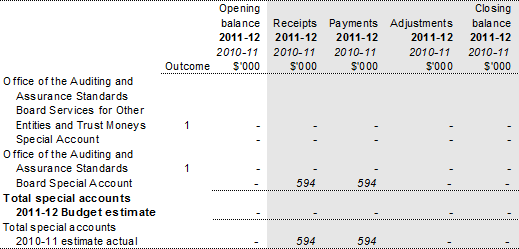
3.1.3 Australian Government Indigenous Expenditure
The AUASB does not have any Australian Government Indigenous Expenditure.
3.2 Budgeted financial statements
3.2.1 Differences in agency resourcing and financial statements
There are no differences between agency resourcing and financial statements.
3.2.2 Analysis of budgeted financial statements
The AUASB is budgeting for a break-even operating result for 2011-12 after adding back non-appropriated depreciation and amortisation expenses.
3.2.3 Budgeted financial statements tables
Table 3.2.1: Budgeted departmental comprehensive income statement
(for the period ended 30 June)
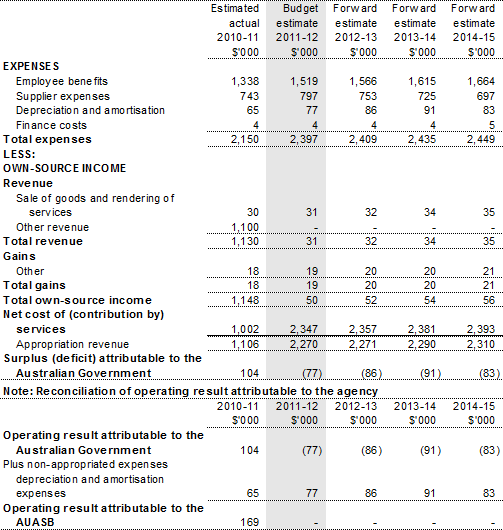
Prepared on Australian Accounting Standards basis.
Table 3.2.2: Budgeted departmental balance sheet
(as at 30 June)
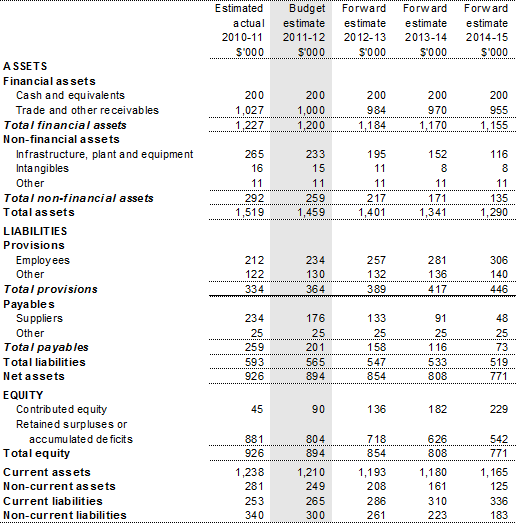
Prepared on Australian Accounting Standards basis.
Table 3.2.3: Budgeted departmental statement of cash flows
(for the period ended 30 June)
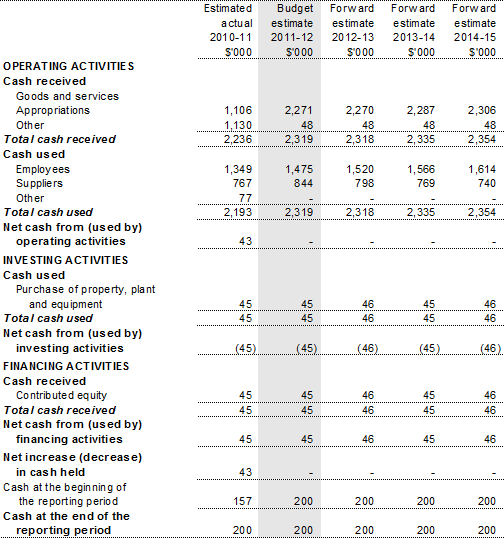
Prepared on Australian Accounting Standards basis.
Table 3.2.4: Departmental statement of changes in equity — summary of
movement (budget year 2011-12)
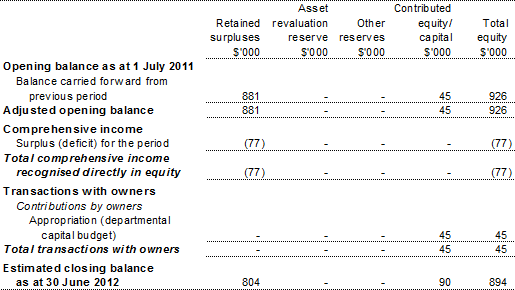
Prepared on Australian Accounting Standards basis.
Table 3.2.5: Departmental capital budget (DCB) statement
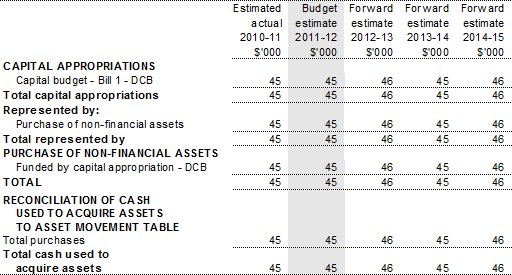
Prepared on Australian Accounting Standards basis.
Table 3.2.6: Statement of asset movements — departmental
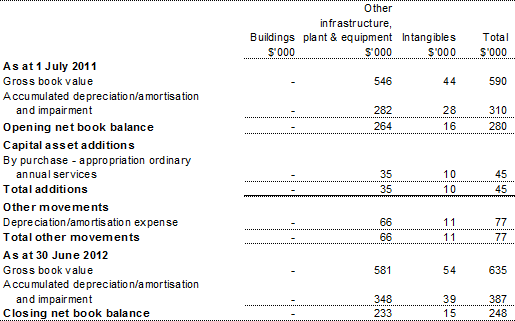
Prepared on Australian Accounting Standards basis.
3.2.4 Notes to the financial statements
The budgeted financial statements have been prepared on an Australian Accounting Standards Basis.